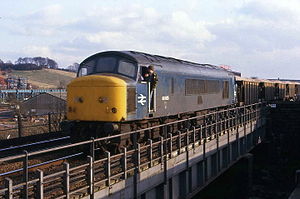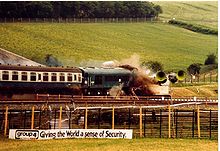- British Rail Class 46
-
Derby Type 4
British Rail Class 46
46035 at Chesterfield. Power type Diesel-electric Builder British Railways’ Derby Works Build date 1961–1963 Total produced 56 Configuration 1Co-Co1 UIC classification (1Co)'(Co1)' Wheel diameter 3 ft 9 in (1.143 m) Minimum curve 3.5 chains (70 m) Wheelbase 59 ft 8 in (18.19 m) Length 67 ft 11 in (20.70 m) Width 8 ft 10 1⁄2 in (2.71 m) Height 12 ft 10 in (3.91 m) Locomotive weight 138 long tons (140 t) Fuel capacity 790 imp gal (3,600 l; 950 US gal) Prime mover Sulzer 12LDA28-B Multiple working ★ Blue Star Top speed 90 mph (145 km/h) Power output Engine: 2,500 bhp (1,864 kW)
At rail: 1,962 hp (1,463 kW)Tractive effort Maximum: 55,000 lbf (245 kN) Train heating Steam Locomotive
brakeforce63 LTf (628 kN) Train brakes Vacuum Career British Railways Number D138–D193; later 46001–46056 Nicknames ‘Peak’ Axle load class Route availability 7 The British Rail Class 46 is a class of diesel locomotive. They were built from 1961-1963 at British Railways' Derby Works and were initially numbered D138-D193. With the arrival of TOPS they were renumbered to Class 46. Fifty-six locomotives were built. The first was withdrawn in 1977 and all of them were withdrawn by 1984.
The Class 46 design was structurally the same as the preceding Class 45 build, and had the same Sulzer engine, but differed in the fitment of a Brush generator and traction motors, in place of the Crompton Parkinson equipment fitted to the Class 45. Along with the other Sulzer class 44 and 45 designs they are often referred to as "Peaks", so named because the earliest of the Class 44 were named after mountains.[1][2]
Contents
Operation
Despite intermittent use on freight trains, Class 46s were regular performers on passenger turns, particularly North East-South West, Trans-Pennine and secondary North East-London trains,[3][2] and depot allocations reflected this with locos at Gateshead, Cardiff and Plymouth in 1977[4] giving a typical spread. Freight workings were also quite often worked over long distances, particularly "clay hoods" carrying china clay from Cornwall to the area around Stoke-on-Trent.
In the 1980s the remaining locomotives were concentrated at Gateshead depot, and the final booked passenger workings for the class were the dated summer Saturday services Bradford - Weymouth (between Bradford and Birmingham New Street), Newcastle - Plymouth, Newcastle - Blackpool North, and York - Blackpool North.[5]
Crash test
On 17 July 1984, 46009 was deliberately crashed into a nuclear waste flask at about 90 mph (145 km/h) on the Old Dalby Test Track in a test organised by the CEGB. It demonstrated to the public that there would be no leak of radioactive material in the event of a rail accident involving a train carrying a nuclear waste flask.[6][7]
46009 was scrapped on site at Old Dalby later the same month by Vic Berry of Leicester. Images
Preservation
Three have been preserved:
- 46010 at Nottingham Transport Heritage Centre
- 46035 Ixion
- D182 at Midland Railway - Butterley
Gallery
References and sources
References
- ^ "Peak to be sold". Railways Illustrated: page 36. November 2007.
- ^ a b Montague, Keith (1978). The Power of the Peaks. Oxford: Oxford Publishing Co. ISBN 0 902888 99 4.
- ^ Lund, E (1980). To the last drop. Chesterfield: Longden technical Publications. ISBN 0 9507063 0 2.
- ^ British Rail Locoshed Book 1981. Shepperton: Ian Allen Ltd. ISBN 0 7110 1112 5.
- ^ Webster, Neil; Greaves, Simon and Greengrass, Robert. Loco-hauled travel 1984-5. York: Metro Enterprises Ltd. ISBN 0 947773 00 2.
- ^ "BBC News report on crash". http://www.youtube.com/watch?v=lHtRZ_k0s7M.
- ^ Clip Animation on crash]
Sources
- Webb, Brian (1978). Sulzer Diesel Locomotives of British Rail. Newton abbott: David & Charles. ISBN 0 7153 7514 8.
Further reading
- McManus, Michael. Ultimate Allocations, British Railways Locomotives 1948 - 1968. Wirral. Michael McManus.
External links
- Crash! - A short article with photographs about the nuclear flask crash test.
- Railblue.com A list of fleet numbers with dates withdrawn.
British railway locomotives and miscellany, 1948 to present Diesel shunters Diesel shunters
(pre-TOPS)Main-line diesels: Main-line diesels
(pre-TOPS)Electrics Electrics
(pre-TOPS)Departmental 97 · 97/6 · Eastern · Southern · Other Series
Prototypes Ships Categories:- 1Co-Co1 locomotives
- British Rail diesel locomotives
- Railway locomotives introduced in 1961
Wikimedia Foundation. 2010.


